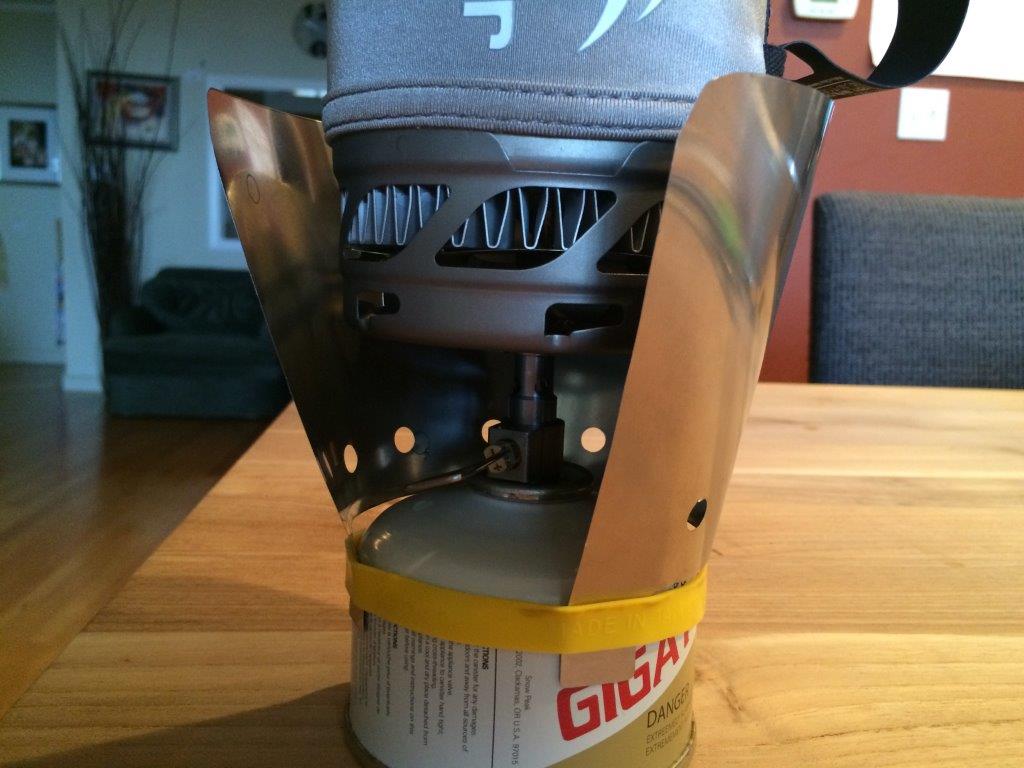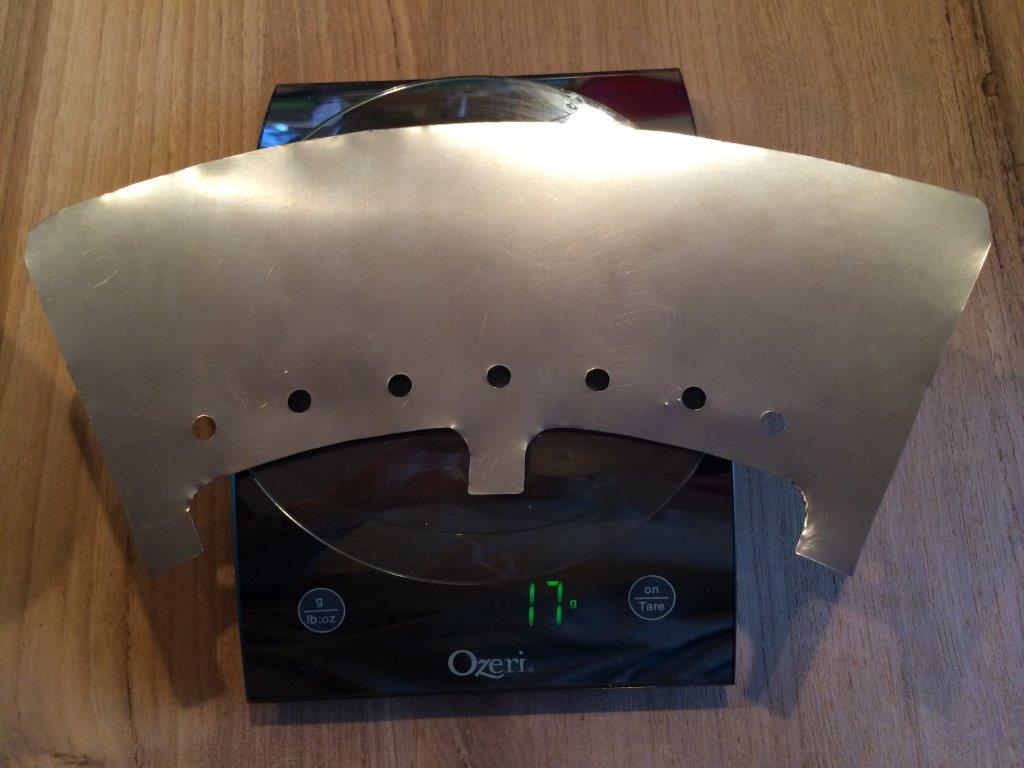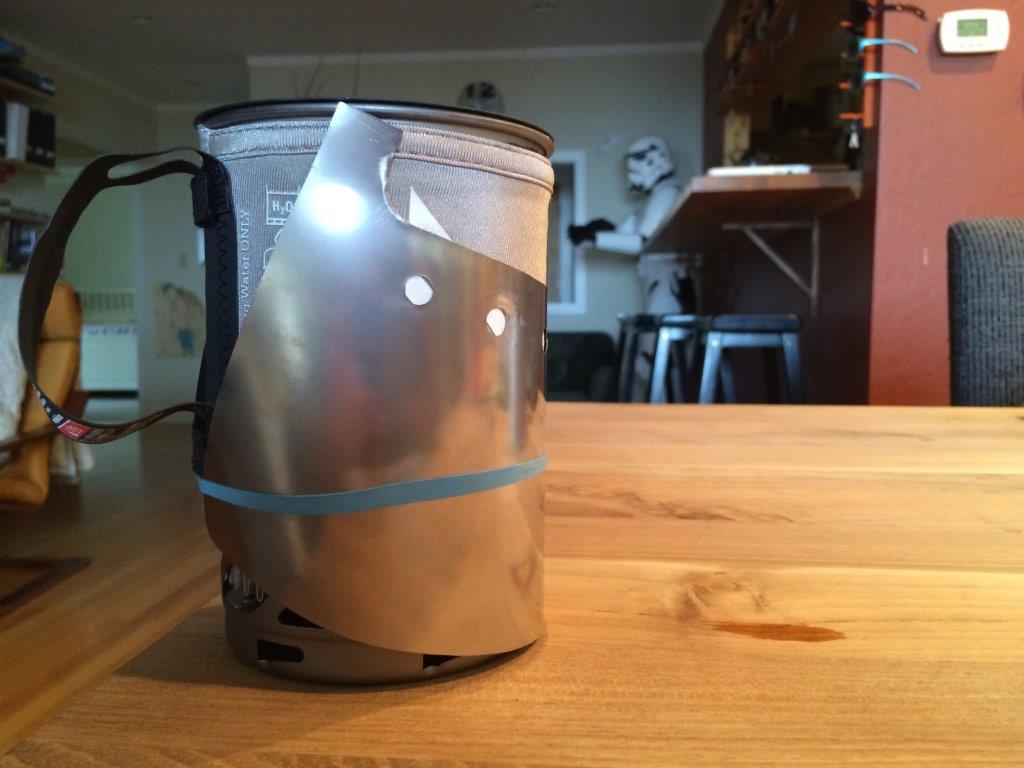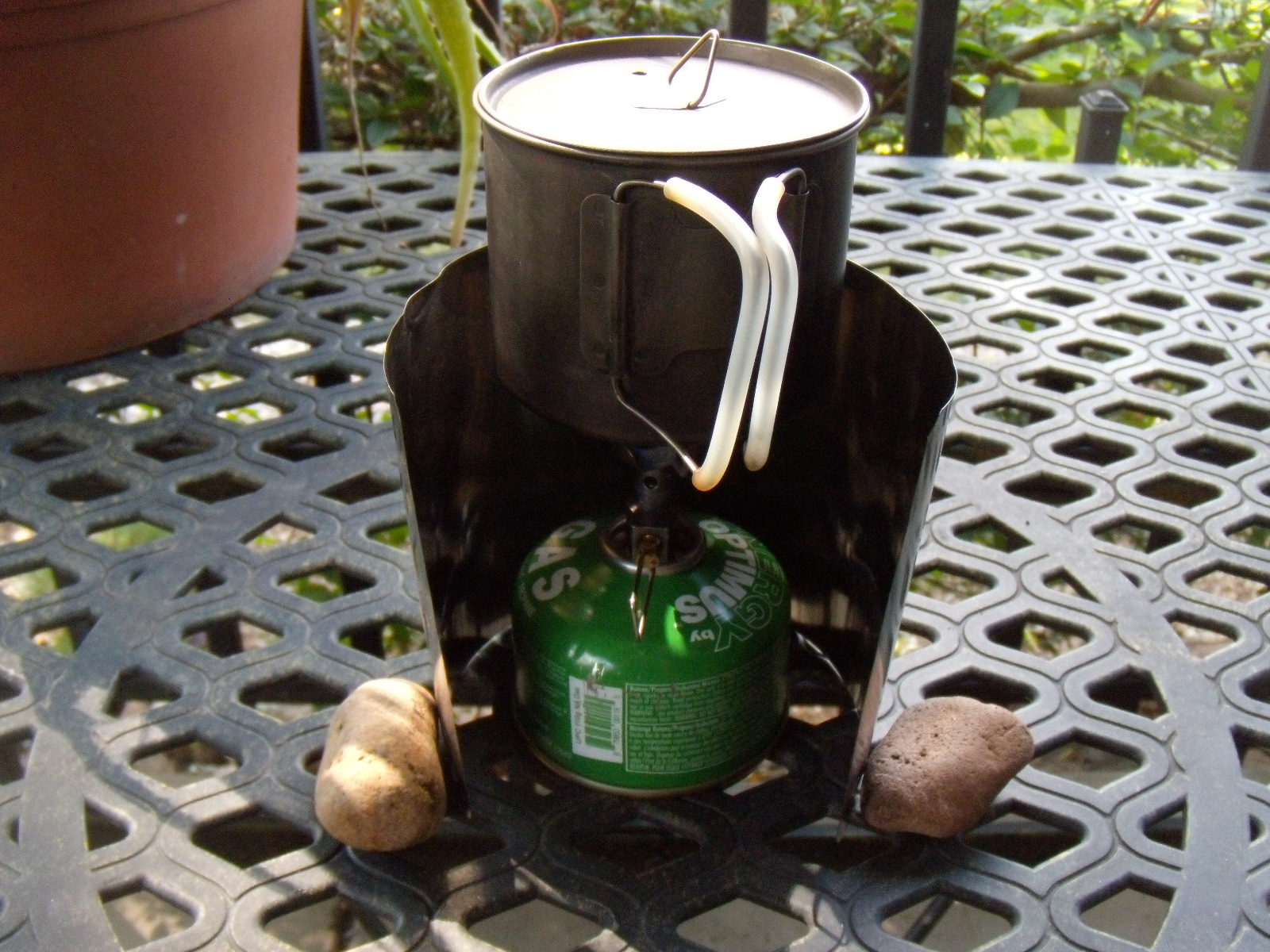Topic
Roger Caffin (or anyone else), is this windscreen safe?
Forum Posting
A Membership is required to post in the forums. Login or become a member to post in the member forums!
Home › Forums › Gear Forums › Make Your Own Gear › Roger Caffin (or anyone else), is this windscreen safe?
- This topic has 41 replies, 11 voices, and was last updated 8 years, 4 months ago by
 HiLight.
HiLight.
-
AuthorPosts
-
Aug 5, 2016 at 11:17 am #3418470
We let the kids choose dinners for our Desolation Wilderness trip last weekend so had the chance to use a Jetboil with a custom windscreen (normally we use a remote canister stove and actually cook in a pot).
Is this windscreen safe? Should I add more holes?
I have read on this site that if you can keep your finger on the top of the canister, then the canister is not too hot and therefore safe. I was able to do that (and have pretty wimpy fingers, at least compared to the those of my wife who is a professional cook).
Thanks in advance.

The windscreen in question. Is it safe (with respect to overheating the canister)?
The windscreen by itself.Aug 5, 2016 at 12:15 pm #3418483That’s pretty creative, Casey, and It looks like it should work. What is the material that you used, titanium, aluminum? Why don’t you tape the tip of a digital kitchen thermometer to the top of the canister (or better yet, slip it into that silicone ring next to where the windscreen tab touches the canister), and then test it in your garage or on your shaded patio. It would be interesting to see how much heat is actually being sent to the canister. If it is minimal, maybe you’ve come up with a winner here.
This might be the most clever MYOG thing I’ve seen on BPL in a couple of months.
Aug 5, 2016 at 1:13 pm #3418493Thanks Gary.
The windscreen is Ti that I purchased from Titanium Goat.
What is considered the “safe” temperature for the canister?
By the way, I’m using the BRS-3000T stove along with your Ti pot riser disk.
Also, the idea is not mine. I found it years ago on BPL (posted by someone from Sweden or Norway I think).
If anyone is interested, I can trace the shape and add a graphic scale so you can print it and trace it for yourself.
Aug 5, 2016 at 1:30 pm #3418500“If anyone is interested, I can trace the shape and add a graphic scale so you can print it and trace it for yourself.”
Please do!
Aug 5, 2016 at 2:00 pm #3418501The wind screen looks fine to me. It does reduce wind flow past the canister’s top (duh), and there’ll be a bit more radiant heat from the warm wind screen down to the canister top, but those won’t be huge effects. And the JetBoil HX extracts more heat from the flame, so the exhaust stream heating the pot sides and the wind screen is cooler.
In the mountains, with a breeze, I wouldn’t be concerned. With no breeze or in hot weather, I’d be checked the canister temperature frequently and would remove the windscreen if the lower portion of the canister felt warm to the touch.
Aug 5, 2016 at 2:10 pm #3418503Doug, I’ll try to post the template here on Monday.
Regarding the windscreen, it is sized so that it can be wrapped around the pot (see photo below).
 Aug 5, 2016 at 2:14 pm #3418504
Aug 5, 2016 at 2:14 pm #3418504Thanks for chiming in David.
The top of the canister definitely gets warm with the windscreen in place, but never too warm to touch or even hold my finger there.
Can the canister explode if the top is warm but the bottom of the sides is cold? This is what happened when I used it.
Aug 5, 2016 at 2:22 pm #3418507I would be slightly concerned with this setup, Especially if it was anywhere near children. I have seen better designs on u-tube (meaning they do a better job keeping heat away from canister).
Aug 5, 2016 at 2:55 pm #3418518Casey, Roger Caffin says that 50* C (122* F) is the “too hot to touch” temperature, and that the canister shouldn’t get any hotter than that. Also, the U.S. DOT requires that the canisters must be constructed such that they can be transported at or below that temperature. We have the advantage that a canister cools itself a bit during use, due to the vaporization of the liquid fuel into the gaseous phase. However, it wouldn’t be prudent to assume that this “self cooling” trait can be trusted to prevent a canister from getting too warm.
After reading your first post, I decided to play around with your concept myself. I didn’t want to cut some titanium until I taught myself the limits of using a windscreen first. I attached my kitchen thermometer sensor to the canister, and then positioned a 3/4 windscreen rather close to the canister. I too used my BRS-3000T stove, but with a small pot on it instead of a JB pot. The ambient temperature was 77* F, and within a few minutes the canister temp was 87* F. I didn’t much like what was happening, so I removed the screen. Within another few minutes the canister temperature dropped down to ambient, and then to 75* F (due to the self-cooling thing). I shut off the stove, as I had learned what I needed to and there was no use wasting fuel.
One other thing I should tell you about: Roger C. did a great experiment to see what the upper temperature limits were for a nearly empty fuel canister (maybe 1/4 full). He placed the canister on a hot plate (with no stove mounted) and remotely raised the temperature slowly, while standing a safe distance away behind a big steel plate. The idea behind the bottom of the canister being concave is that theoretically the bottom would bulge outward when the interior pressure got too high, giving the operator time to quickly cool the canister somehow. What Roger found was that it indeed did bulge outward first, but only maybe a nano-second before the whole canister shot 50+ feet into the air as an explosive ball of flame. This occurred at a temperature of close to 200* F, if I recall correctly. A full canister certainly would fail at a much lower temperature, but it’s anybody’s guess as to just what that would be. If I lived in Phoenix, I wouldn’t store canister fuel in the trunk of my car during the summer.
I think that you have come up with a very viable, and probably safe solution to protecting a stove from wind, Casey. As you probably know, the BRS-3000T stove is a bit more susceptible to wind than some stoves, and the JB heat exchanger fins don’t do a great job of blocking a stiff breeze. Your solution looks to be the bee’s knees.
Aug 5, 2016 at 3:10 pm #3418524Thanks again Gary. I was reading Roger’s article (see link below) while you were typing the post above.
https://backpackinglight.com/exploding_gas_canisters_the_hazard_of_overheating/
So 50 degrees C (or 122 degrees F) is the number I was looking for. I may experiment with aluminum radiation shields this weekend…
Aug 5, 2016 at 3:23 pm #3418526Can the canister explode if the top is warm but the bottom of the sides is cold? This is what happened when I used it.
Subsequent searching on BPL shows that this question has already been asked (by Jerry, see link below) and answered by no less than David T. and Roger.
Aug 5, 2016 at 3:55 pm #3418535I’ve used a titanium ‘screen’ re-purposed from an old alcohol/twig burning stove in conjunction with a pocket rocket. I’ve left less area open than you do in your pictures and never had an issue. But I was solo cooking and could get a boil in about three minutes. For sure, I test the canister the whole time. The screen really cuts down on fuel and speeds up boiling time. (I only boil)–as you know.
the nice thing about this ‘screen’ is that I could still use twigs to get a boil by placing tent stakes at the top in the provided slits to hold the pot. In the event of something happening…like my canister exploding (or running out of fuel).
sorry, I’m blanking on the name of this stove!
Aug 5, 2016 at 3:57 pm #3418536It says on the side of the canister to not store canister above 50 C or 120 F. That means that the liquid in the canister can get to that temperature.
That’s consistent with David and Roger’s advice that top of canister can be warmer, but the side of the canister opposite where the fuel is should be less than 120 or 122 F
Gary, your windscreen would be great in the winter when it’s below freezing. Ordinarily, you can’t use an upright below about 25 F. That would allow you to use it at 20 F or 15 F. Or, a 1 foot square of aluminum foil underneath, folded up a bit to better reflect heat to canister.
If I am ever where it is below 25 F, I will try this, but I missed any opportunity last winter, darn global warming : )
Aug 5, 2016 at 4:38 pm #3418545Hi Casey
That is a very interesting case as at first glance it seems it might breach some ‘safety rules’, but maybe not. I will waffle on a bit: see what you think.
First of all, the windshield is in good contact with the canister, so it should be heating the canister up. That’s potentially not good. However, the windshield is thin Ti foil, so the actual amount of heat flow reaching the canister won’t be all that high. Also, the full length of the foil is not in use, just a couple of tabs. Reduced contact area, less heat flow. Also, the incoming air may be cooling the foil slightly – maybe. In summary, I don’t think that I would be worrying about the heat conduction for titanium. Heavy aluminium shim might be more of a worry, maybe.
Second, it seems that the Ti foil is touching the bottom rim of the heat exchanger (HE). This will block some of the air flow up past the side of the pot: not so good. But that is the bottom rim of the HE, and most of the hot air will be coming out the side of the HE, above the point of contact. It will be able to go up the side of the pot. Provided that the foil does not obstruct the flow out of the HE too much, there should not be a problem. Looking at the photo, I would give this a pass.
The hot air coming out of the HE will of course be heating the foil. However, it has been noted that the temperature of the hot air coming out from a HE is remarkably low: it is a heat exchanger after all. Think foam cozies. I suspect this won’t be a problem.
Some hot air will be trapped under the pot by the HE against the rim. Well, yes, but not too much, and it can escape via the large opening at the front. Pass.
All this is great theory, but it needs confirming with a decent amount of field testing. You mentioned that the canister passed the ‘finger test’, so that seems to be a pass as well. Really, one should always be using the finger test when cooking, just to be safe. Just IMHO.
Yeah, it looks OK to me. In fact, I would be curious to know how much hotter a canister with an aluminium foil version might get. All in all, maybe not much hotter. After all, those tabs are not ‘full contact’ anyhow. Definitely innovative!
But this will NOT work without the HE rim as shown. It is NOT for a conventional pot!
Cheers
Aug 5, 2016 at 5:46 pm #3418555@ Jerry:
Did you forget that Bob Moulder and I have the winter canister thing solved, with our copper strips? We are good down to 0* F, below which I’m checking into a Holiday Inn. This thread is all about wind mitigation, right?
I’m wondering why Art didn’t give us a link to those “better than Casey’s” wind screens.
Aug 5, 2016 at 6:01 pm #3418557No, I’m not forgetting : )
But a 1 foot square of aluminum foil may be just as good, maybe better, Weighs less and easier to construct.
Aug 5, 2016 at 6:14 pm #3418559Hi Gary
Forgive me, but i do not see the relevance. Copper heat shunts, which are far older than Bob Moulder’s version (by 10 or 20 years), are for heating the canister in cold weather. What Casey is showing is a windshield for use with a HE pot. As far as I can see, the two are completely separate things. Hey – you could even use both together in very cold weather.
Cheers
Aug 5, 2016 at 6:36 pm #3418563“” I’m wondering why Art didn’t give us a link … bla bla “”
mainly because I didn’t see it as my job to go look them up again.
but the wind screens that look much safer are basically inverted Teepees that do not touch the canister at all, and block almost all heat from descending to the canister.
I’m sorry, but most of this thread seems to be about trying to justify a mediocre design. The energy should be put into the safest most efficient design you all can come up with … especially if this will be around children.
Aug 5, 2016 at 10:05 pm #3418578Roger,
Thank you so much for the thoughtful response.
Regarding your second comment, the Ti foil does NOT touch the bottom of the heat exchanger. I’ll try to take a clearer picture and post it later.
Based on your comments, and your excellent canister explosion experiment from several years ago, I think I may make an aluminum heat reflector and cut away some of the foil between the tabs.
Thanks again.
Aug 5, 2016 at 10:13 pm #3418579Hi Casey
And even if the Ti foil did just touch a little, it probably would not matter WITH A HE POT. A plain pot would be another matter entirely.
Yeah, I would be interested in the results with Al shim.
Cheers
Aug 6, 2016 at 5:29 am #3418597Looks very good!
Have you tested it in the wind yet?
Sometimes the wind eddies on the leeward (open) side can be quite turbulent. It occurs to me that you might actually need more holes down low to reduce the negative pressure of the eddies. What makes me think of this is the hole pattern on the MSR Windboiler windscreen.
Aug 6, 2016 at 8:06 am #3418603“As far as I can see, the two are completely separate things.”
Both that windscreen and the Moulder strip conduct heat down to the canister. Windscreen – radiative heat, strip – conductive heat.
Both push the lower operating temperature
Both could be a problem in warm weather and overheat the canister
I agree with Art this isn’t the best design for a windscreen in warm weather, plus it probably isn’t the best for wind protection, but it is very lightweight and compact so maybe it’s just fine
Aug 6, 2016 at 9:24 am #3418611I’m sorry, but most of this thread seems to be about trying to justify a mediocre design. The energy should be put into the safest most efficient design you all can come up with … especially if this will be around children.
Well, it needs to be tested in a variety of conditions.
Maybe it will work well and be totally safe, but for those first tests it would be wise to have several thermometers for taking readings at obvious critical points of the system. However, the fact that it already passes the “touch test” is very promising. Ti is less heat conductive than Al, and also more durable, and therefore would be my choice for this application.
My winter set-up uses an HX pot (MiniMo or Sumo) so this might work well, as Roger suggests, in concert with my HX strip thingy in a very cold weather situation.
Roger, I hear what you’re saying about the relative antiquity of the copper heat shunt idea. (In fact, it has probably been around much longer than 20 years, since a few days after the invention of the canister.) Being very familiar with this concept by now and having tried earlier versions, however, I can say unequivocally that previous attempts were for the most part kludgy, unreliable, heavier than necessary and not as effective. My goal was to simplify that concept and make something that is modular, easy to deploy, safe, consistently reliable and lightweight.
Vortex burners have also been around quite a while but that doesn’t mean they can’t be improved upon. :^)
Aug 6, 2016 at 3:51 pm #3418669I think Bob and I are in agreement.
There has been some concern (Jerry et al) that the windscreen might conduct too much heat to the canister, so checking the canister temp is (always) important. Casey found that with his rig it was OK, but Gary found that with an aluminium version and an ordinary pot the canister started to get warm (77 F -> 87 F), but that is as I expected. However, I suspect the problem was more the ordinary pot rather than the metal used. I suggest that this is not a design for use with ordinary pots.
We still need someone to experiment with an aluminium version and a HE pot such as the JB. Volunteers?
Cheers
Aug 6, 2016 at 4:14 pm #3418671No. Roger, my 3/4 wind screen was a piece of titanium foil. Here’s how I had it set up, except that I had taped the sensor tip of my digital kitchen thermometer to one side of the fuel canister. I intentionally positioned the wind screen pretty close to the canister, with maybe a gap of 1″ on three sides of the pot.

The canister likely received a bit of ventilation via the lattice openings of the table top. However, the speed at which the canister warmed up told me what the safety limits of a relatively tight wind screen might be.
-
AuthorPosts
- You must be logged in to reply to this topic.
Forum Posting
A Membership is required to post in the forums. Login or become a member to post in the member forums!
HAPPENING RIGHT NOW (February 11-21, 2025) - Shop Hyperlite Mountain Gear's Biggest Sale of the Year:
Our Community Posts are Moderated
Backpacking Light community posts are moderated and here to foster helpful and positive discussions about lightweight backpacking. Please be mindful of our values and boundaries and review our Community Guidelines prior to posting.
Get the Newsletter
Gear Research & Discovery Tools
- Browse our curated Gear Shop
- See the latest Gear Deals and Sales
- Our Recommendations
- Search for Gear on Sale with the Gear Finder
- Used Gear Swap
- Member Gear Reviews and BPL Gear Review Articles
- Browse by Gear Type or Brand.







